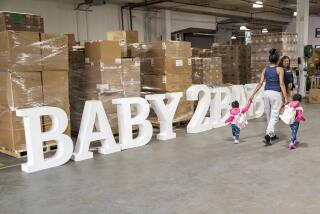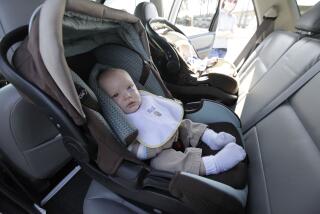THE GOODS : Baby Booty : A dizzying array of items make it hard to choose what’s best for baby. But this guide could help you decide if you really need that bassinet.
- Share via
After her friends threw her a “fabulous” baby shower, and after getting a shipment of hand-me-down baby furniture from her cousin, Sandra Braun decided to buy a few missing odds and ends for her soon-to-be-born first baby.
Three hours and two stores later, the odds and ends, ranging from bottles, diapers and bibs to a rubber ducky, ended up costing a whopping $700. “Frankly, I don’t think I went overboard,” says Braun. “Yes, it was more than I planned to spend but I need everything.”
*
It’s every first-time parent’s dilemma. Baby is only months away and that spare bedroom has yet to be converted from office space to nursery. But when Mom and Pop check out that baby store, panic sets in.
Cribs and strollers and car seats, Oh my! Faced with dozens of choices on every single item and with prices varying by as much as hundreds of dollars, what are first-time parents to do?
Baby showers aside, supplying your infant’s immediate needs should not be such a daunting task. And although you can easily end up plunking down a couple of grand, you can cut costs without sacrificing quality.
Southern California offers a wide array of places to shop for baby, from discount department stores, ideal for staples such as diapers and bottles, to pricier baby boutiques that sell high-end imported carriages and allow you to order specific bedding from their catalogues.
Here is what the experts--from moms and pops to baby store sales people to manufacturers and health care providers--have to say about essential and not-so-essential items for those first months.
*
* Cribs: With prices ranging from about $100 up to $700, a new crib is probably the single most expensive prop you’ll need for your little one. Keep in mind comfort and looks, but remember, that the “look” and the brand, more than quality itself, hikes up a crib’s price.
Nowadays, most cribs have two drop sides (sides that go up and down for easy access to your baby) and mattress-height adjustment mechanisms. Being able to lift or lower the mattress not only relieves stress on your back from constantly leaning over to pick up your baby, but also lets you lower the mattress so sides remain high enough to protect the baby when he starts growing. Cribs that have only one drop side may be considerably cheaper.
Wooden cribs are usually costlier, and expensive cribs also have little conveniences, like bottom or side drawers, that cheaper models bypass.
*
* Bedding, mattress: Surprise, surprise. The price of a crib does not include the mattress or those cute sheet sets. Choose the mattress as if it were your own, opting for firmness and making sure it will keep dry. Prices start from $50 to $100 or more.
As far as bedding is concerned, you’ll need mattress pads, several waterproof and regular sheets, blankets, dust ruffle and a quilt. An essential item is the bumper, the padding that circles the inside of the crib and protects your baby from banging against crib sides when tossing and turning. Your baby won’t need a pillow for a while, so don’t bother.
*
* Bassinet or cradle: Yes, they’re awfully cute, but do you really need one? Remember, you’re paying for the bassinet (about $45 to the $100s) and the bedding that comes with it. And, you’ll only be able to use it for a couple of months (your growing baby can tip it over) before switching to a regular crib.
Consider a bassinet if you must absolutely have that baby by your bed and the crib is either too large for your room or you don’t feel like reassembling it later on. Bassinets are also easy to wheel around, which you can’t do with a crib.
*
* Car seat: They are required by law for all children 4 and younger and those who weigh 40 pounds or less, so don’t leave home without it. For your newborn, you have the option of buying an infant car seat, which will accommodate a child of up to 20 pounds (about six months), or a convertible car seat, which can be used from birth up to 40 pounds.
Despite the extra cost, all moms we spoke with voted for initially buying an infant seat, which doubles as an infant carrier, and then shelling out the extra bucks for a regular car seat.
For not that much money (about $50 to $60), the infant seat/carrier can be snapped off its base (which remains inside your car) and used as a baby carrier. This makes it easy to get your newborn in and out of the car and lug him around without waking him up. Convertible car seats aren’t nearly as portable (if at all) and may be too big for some infants.
Finally, some companies now manufacture car seats that can double as carrier and stroller, using a standard stroller frame. If you’re not set on a particular type of stroller, consider this very practical option.
Because child safety seats are sometimes recalled, you might check with Consumer Reports for safety ratings before buying a specific seat.
*
* Stroller: No, they’re not an absolute necessity for a newborn, particularly if you have the car seat/carrier. But somewhere down the line, you’ll want that stroller.
Like cribs, strollers can vary widely in price depending on the manufacturer. Inglesina’s top-of-the-line stroller, for example, made in Italy and decidedly very chic, runs $500.
But before you get seduced by a stroller’s snazzy looks, set your priorities straight. The biggest carriage/strollers (so-called because they can alternate from lie-down carriage to upright stroller) tend to be more comfortable for your baby, sturdier, prettier and yes, more expensive. Because of their sheer size and weight they are also harder to store than lightweight models.
If you will be taking your stroller in and out of cars a lot, a heavy stroller won’t work for you. Opt for something light that, while not as versatile or comfortable, can be easily carried in and out of your vehicle and is cheaper.
Whatever you decide, your newborn needs to be able to fully recline in his stroller until he can sit up.
Bottom line: Unless you want to buy more than one stroller, opt for a carriage/stroller that grows with your baby. Some moms recommend a “good” sturdy stroller for everyday use and a very cheap umbrella stroller to keep in the car.
*
* Changing Table: Some moms swear by them, some discount them as useless. A changing table with its bottom shelves makes for an organized changing area and doesn’t require you to bend over.
On the other hand, it takes up space, and you can change the baby just as well on virtually any flat surface. A good inexpensive option: a changing pad that can be secured onto your chest of drawers and is easily stored. More expensive but practical: the infant bathtub that doubles as changing table. Also known as a Bathinette, prices start in the $70s and go up to about $120.
*
* Playpen: Another love-hate item. Some parents hate the idea of “confining” the baby. But if you like to take junior to the beach or park, the so-called portable crib, which doubles as crib and playpen, is easy to store and carry. It will set you back close to $100, though.
*
* Bath Essentials: Infant bathtubs are an absolute must (unless you have the Bathinette) and depending where you buy them, can range from $5.99 to $24. You’ll also need a bath sponge, hooded towels and wash cloths.
*
* Wardrobe: Stock up on basics like infant T-shirts. Same goes for stretchies, rompers, socks, mittens and receiving blankets. Regardless of the weather, your baby’s body does not regulate temperature well and needs to be kept warm. Don’t go crazy, though. They’ll outgrow everything.
*
* Diapers: Cloth or disposables? Your choice. The cost of a cloth diaper service is slightly more expensive unless you wash diapers yourself and that can get old pretty quickly.
Although cloth diapers are more environmentally friendly and work well with sensitive-skin babies, they are messier and have to be changed more often. If you really want them, consider using disposables at night so your baby can sleep dry without having to be changed.
*
* Food. Your cheapest alternative, of course, is breast-feeding. If using formula, you will need bottles, nipples and caps, bottle sterilizer and bottle warmer. A nursing set will provide the essentials in one nifty package and breast-feeding moms will need the same paraphernalia once they start storing their milk in bottles.
And all breast-feeding moms agree: The best invention ever is a breast pump. Buy your own ($100 and less) or rent. While renting is more expensive (at about $250 or a bit more for six months), many moms say rental pumps are better and quicker.
*
* Baby Monitor: Another big-time popularity item among first-time mothers, especially if you live in a two-story home.
*
* First-Aid Kit: At the very least, keep an infant thermometer handy and blunt scissors to clip baby’s brisk growing nails.
*
* Toys: At the top of the list, a mobile, ideally that plays music and rotates, to hang over your baby’s crib. They help the baby’s visual and auditory pathways mature, according to experts. Since babies don’t distinguish colors during the first weeks, buy one that is half black and white, half colored.
Whatever you buy for your baby, do your homework and take the time to shop around as prices vary dramatically from store to store. Do consider buying resale items but never compromise your child’s safety to save money. Older car seats, cribs and strollers might not adhere to tougher safety standards, so be well-informed.
Finally, bear in mind that there are no hard and fast rules when shopping for your baby. After all, what works for some infants might not work for yours. Remember, it’s all part of the adventure.






